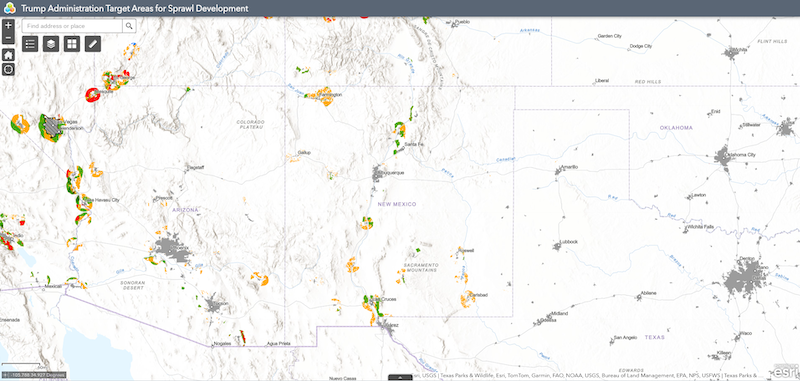|
Interior eyes federal lands for housing By Hannah Grover Courtesy of NM Political Report Federal lands near Española and Santa Fe could be sold off as part of an effort to increase affordable housing, according to the advocacy group Center for Biological Diversity.
Those lands include places near the Ojo Caliente Area of Critical Environmental Concern, where there are Native American cultural sites and mineral springs, and the La Cienega Area of Critical Environmental Concern. The Center for Biological Diversity mapped out Bureau of Land Management parcels within ten miles of municipalities that have at least 5,000 residents. These are lands that the Department of the Interior has indicated may be sold to increase access to affordable housing. In March, Interior Secretary Doug Burgum and Housing and Urban Development Secretary Scott Turner announced a partnership to look at turning federal lands into housing. “Our lands are an incredible asset on America’s balance sheet and we’ve been discussing how we can efficiently and effectively steward these underutilized areas to solve our nation’s affordable housing crisis,” Burgum said in the announcement video. Turner said the two agencies will collaborate to determine where federal lands may be available for “tailored housing programs.” Randi Spivak, the public lands policy director with the Center for Biological Diversity, acknowledged that there is an issue with affordable housing, but said she has a “trust issue with this administration.” “We don’t know how much land, ultimately, BLM will sell off,” she said. However, Spivak said the two federal agencies have talked about 440,000 acres. That prompted the Center for Biological Diversity to look at what lands fall within the parameters outlined by the two agencies. “We don’t know what BLM is going to do yet, but I think in part, we wanted to do this for two reasons,” Spivak said. First, she said the organization wanted to see what areas of critical importance fall into the criteria for potential sales. Additionally, she said the Center wanted to “send a message” that some areas should not be “tampered with or encroached upon.” The map uses different colors to show areas of critical environmental concern, wilderness areas, wilderness study areas, national monuments, wild and scenic rivers and other BLM lands that have some form of protection compared to other BLM lands. Spivak said if the BLM attempted to sell off lands in those protected areas, the agency would “have a big fight on their hands.” But even if the BLM did not directly sell off lands in protected areas like the Ojo Caliente ACEC, Spivak said the places could be harmed by having houses built adjacent to them. This could increase demands for water resources in the area and lead to more traffic as people recreate in areas near their houses. Additionally, Spivak highlighted recent layoffs at federal agencies including the BLM. She expressed concern that the layoffs will result in fewer resources. “There’s going to be very, very little oversight and enforcement,” she said. While the proposed sale of federal lands is intended to address housing shortages, critics have questioned if that would be the end result. A story by Bloomberg about federal land sales in Nevada that were intended to address the housing crisis found that only a small percentage of the lands sold were developed as affordable housing. Of the 18,000 acres sold in Nevada, only 30 were used to increase affordable housing availability. The plan comes as the Trump administration has targeted programs intended to protect public lands and the environment. This week, Trump announced the recission of the BLM’s Public Lands Rule, which aimed to put conservation on equal footing with other uses such as oil and gas development and grazing. “President Trump is clearing a path to sell out some of the country’s most precious public lands to the highest bidder,” Drew McConville, a senior conservation fellow for the Center for American Progress, said in a statement. “The White House is now targeting the rules that conserve these sensitive lands for future generations – from the migration routes of Arctic caribou to treasured landscapes of the southwest. Gutting these protections may serve the narrow interests of insider oil and gas executives and other billionaire donors, but it squanders America’s public lands legacy.”
1 Comment
Ann Cunningham
4/23/2025 12:37:47 pm
In addition to destroying sacred sites, there is no assessment of water, electric, medical, shopping, educational, fire fighting, etc. availability. All are necessary for a liveable community! As usual, this is another looming fiasco that had no planning, thought or research.
Reply
Your comment will be posted after it is approved.
Leave a Reply. |
Submit your ideas for local feature articles
Profiles Gardening Recipes Observations Birding Essays Hiking AuthorsYou! Archives
April 2025
Categories
All
|

 RSS Feed
RSS Feed